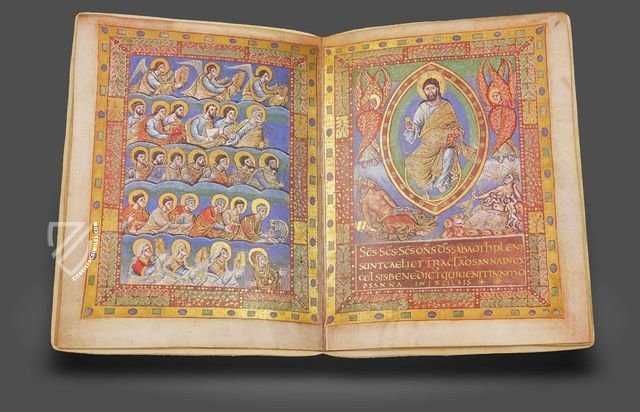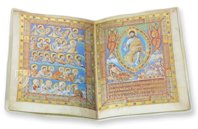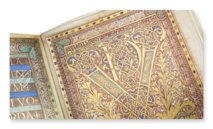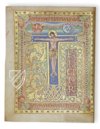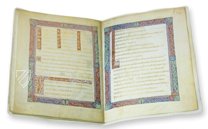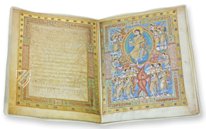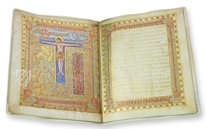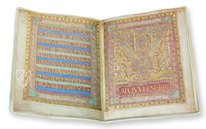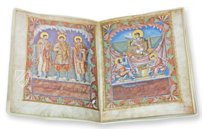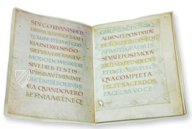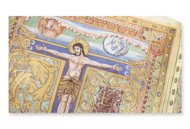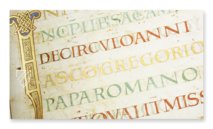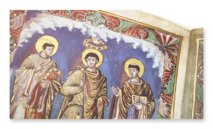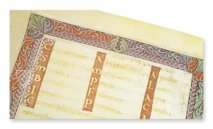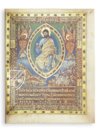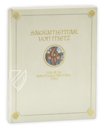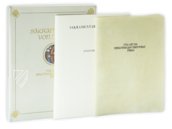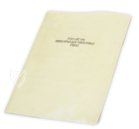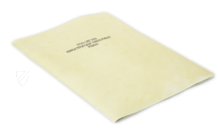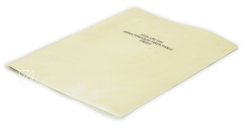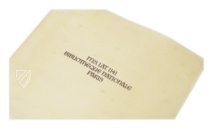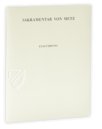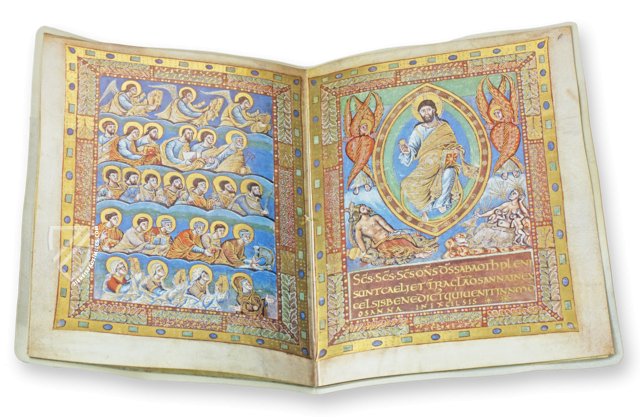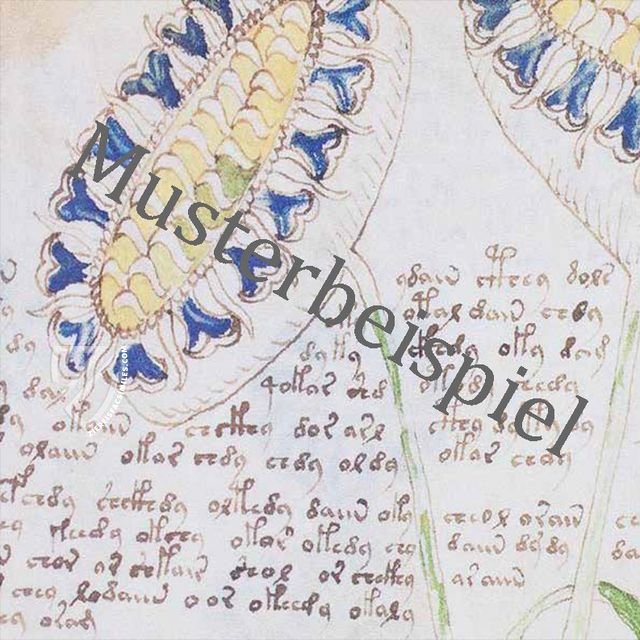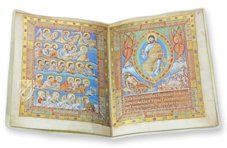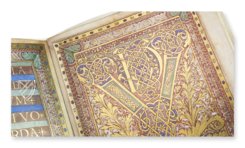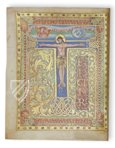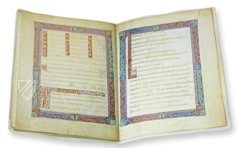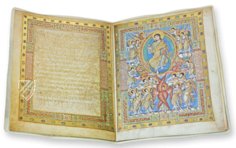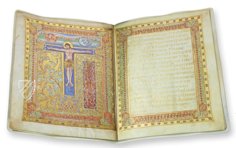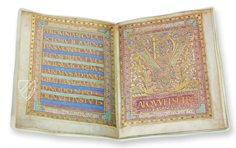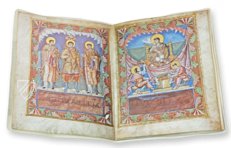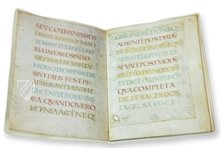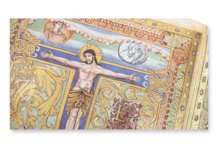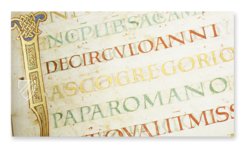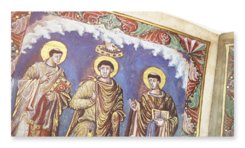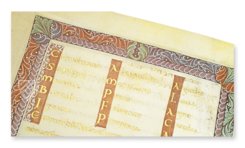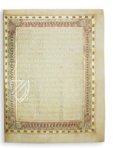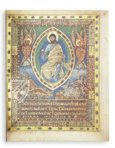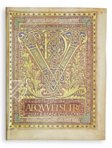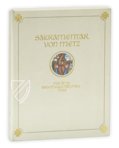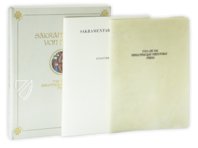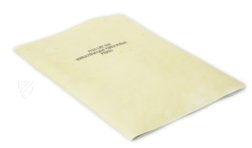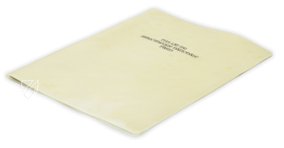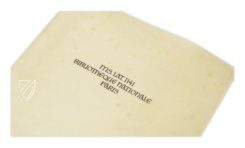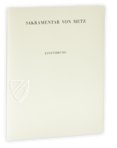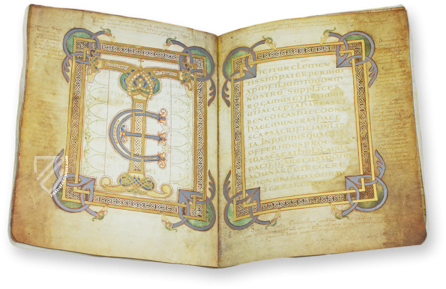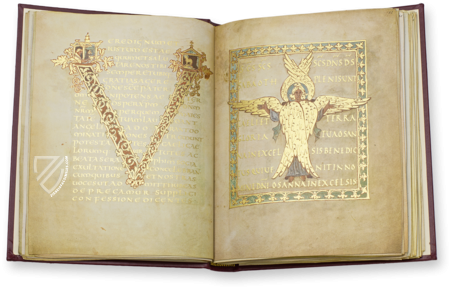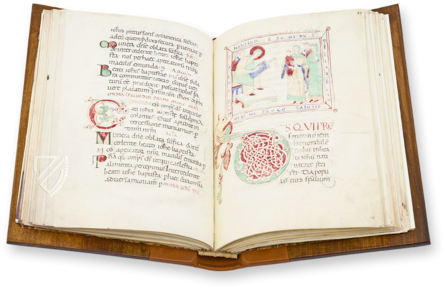Sacramentary of Charles the Bald
(1,000€ - 3,000€)
Why the Sacramentary of Metz exists today as a fragment is disputed: is it a whim of tradition that allowed only the 10 surviving leaves to come down to us today, or was the codex not continued at all after the Canon missae that still survives today? Whatever the answer to this question is, it was created in the 2nd half of the 9th century for Charles the Bald (823-877) by his court school and represents one of the most precious testimonies to late Carolingian illumination today . The depiction of the hand of God at the coronation of the king, for example, is without parallel in Carolingian art, but aptly sums up the self-image of the Carolingian dynasty. The royal splendor of the coveted treasure can also be attested to by the rich ornamentation, which, in addition to the 7 full-page miniatures, seeks to emphasize the theological content in its own way.
Sacramentary of Charles the Bald
The Sacramentary of Metz constitutes a bibliophile jewel which, due to its rich ornamental and miniature decoration, surpasses everything which has come down to us in the canon pages of other medieval sacramentaries. Although the codex is a complete sacramentary which integrates the whole ecclesiastical year, it nonetheless constitutes a fragment, even while still containing the most important portion of the sacramentary (the Canon Missale with the Preface). It has also been suggested that this is only the beginning of a work which has never been completed. Our manuscript has thus always been known and become famous as a sacramentary fragment, its luxury making it one of the most precious testimonies to late Carolingian illumination. It was made in the second half of the 9th century for a king, probably for Charles the Bald, king of an area then called Francia Occidentalis. Both the script, which is mainly executed in golden letters, and the decoration with ornament and miniatures, are of great artistic value and marvelously enhance the contents of the sacred text. The imagery developed in Reims and Metz from late classical vocabulary comes alive in the manuscript which is also influenced by the magnificent Tours school. The existing elements are grouped to a new harmony, and pictorial forms are created which were to influence medieval art for many centuries.
The Unique Decorative Apparatus
Although the manuscript only comprises a few pages (10 folios), it contains magnificent depictions showing great movement and vivacity. At the beginning of the manuscript stands the portrait of the sovereign, depicting the coronation of Charles the Bald by the hand of God. This miniature presents some interesting iconographic details, such as the haloes around the heads of the king and the two bishops, which are interpreted as attributes to those involved in sacramental doings. In addition, an old motif from late classical triumphal art, the coronation of the emperor by the hand of God, attracts the viewer’s attention, as it is unparalleled in the Carolingian period. It constitutes the most unambiguous expression of the conceited idea that royalty is immediately bestowed by God.
Imaginative Ornamental Art
Besides a total of seven sumptuous full-page miniatures, the ornamental decoration is of great importance. It underlines the theological contents and excels in a rich formal vocabulary, great inventiveness and determination, both in detail and in the overall conception of the work. Acanthus leaves, colored pearl bands, frames of precious stones, blossom rosettes, and palmettes imaginatively wind around the holy text. The overall goal of deploying great pomp and presenting wealth and plenteousness, is clearly visible throughout the book.
A Masterpiece of Calligraphy
The graphical presentation of the manuscript is an excellent example of the decorative use and combination of different scripts in a calligraphic masterpiece. The text is predominantly written in gold and on some pages, lines alternate in gold, green and red. The letters are frequently decorated with ornament and some lines and letters are highlighted by purple backgrounds. Besides a fine minuscule, all kinds of decorative scripts are used: capitalis quadrata, capitalis rustica, as well as sumptuous uncials for the main portion of the text.
A King’s Sacramentary
Sacred books used in coronation ceremonies as well as for other celebrations and ritual feasts, were intended to invoke God’s blessing for the sovereign and the whole dynasty. This is probably the context in which the Sacramentary of Metz should be placed. The reason why it remained unfinished might have been the urgent need for a sumptuous sacramentary at the occasion of the coronation of Charles the Bald, as well as the fact that for lack of a complete manuscript, one had to do with the precious fragment, which was just started at the time and contained only the first and foremost portion of the Sacramentary. Based on the rich decorative apparatus, it is possible to state that the Sacramentary goes back to the time of Charles the Bald and is considered today to be the work of a school active at his court.
Codicology
- Alternative Titles
- Sacramentaire de Metz
Sakramentar von Metz
Sacramentary of Metz
Le Sacramentaire de Metz
Sacramentaire de Charles le Chauve
Sacramentario de Carlos el Calvo - Size / Format
- 20 pages / 27.0 × 21.0 cm
- Origin
- France
- Date
- 2nd half of the 9th century
- Epochs
- Style
- Language
- Script
- Carolingian minuscule Roman uncial Roman rustic capitals
- Illustrations
- 7 full-page miniatures, 12 pages with ornamental frames and with splendid ornamental writing
- Patron
- Emperor Charles the Bald (823–877)
- Artist / School
- Schools of Tours
- Previous Owners
- Louis XV., Jean-Baptiste Colbert
Sacramentary of Charles the Bald
Christ in Majesty
Meaning “almond” in Italian, a mandorla is an almond-shaped frame in which Christ and/or the Virgin Mary are presented, usually surrounded by the Evangelist Symbols or other icons. This particularly colorful and richly gilded miniature shows Christ flanked by two seraphim – angels belonging to the highest of the angelic choirs and described in Isaiah 6 as surrounding God’s throne continuously singing “holy, holy, holy”. A man holding a fish and woman suckling two babes gaze up at this glory.
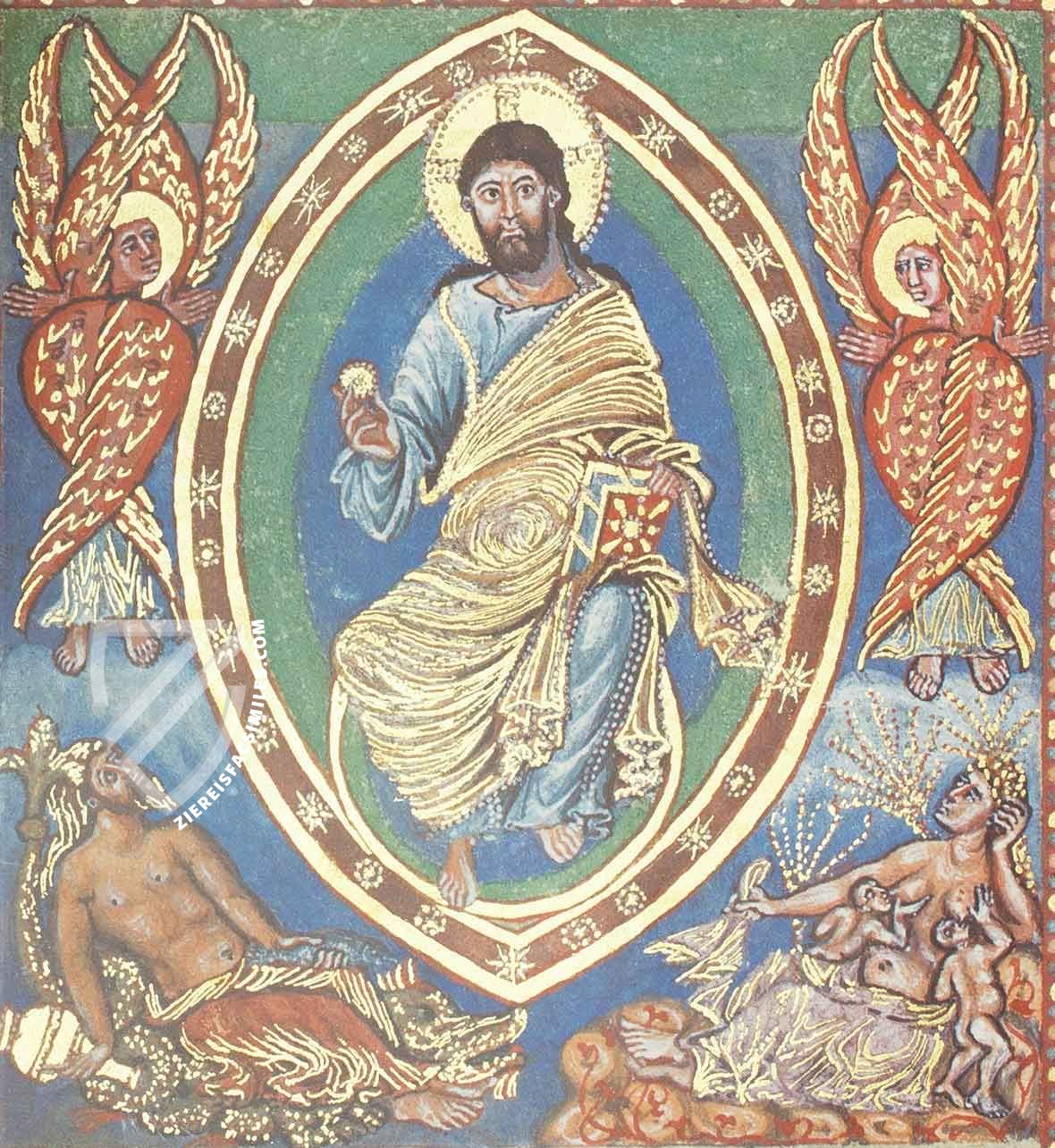
Sacramentary of Charles the Bald
Crucifixion – Te Igitur
This lavish Crucifixion scene, in which the cross forms the opening “T” of the Eucharistic prayer Te igitur, is evidence that this fragment contains arguably the richest and finest Carolingian illumination. The miniature is a kaleidoscope of interlace patterns, gems, pearls, palmettes, and acanthus leaves. Aside from the lavish use of gold leaf, the scene employs radiant shades of red, green, and blue.
Although bleeding from his wounds, Christ is shown triumphant over death with his eyes wide open and appears to stand rather than hang from the cross. Gold dots represent the nails in his feet, hands, and curiously, his nipples and bellybutton. Christ’s musculature is surprisingly realistic for the period and contrasts with his solemn appearance.
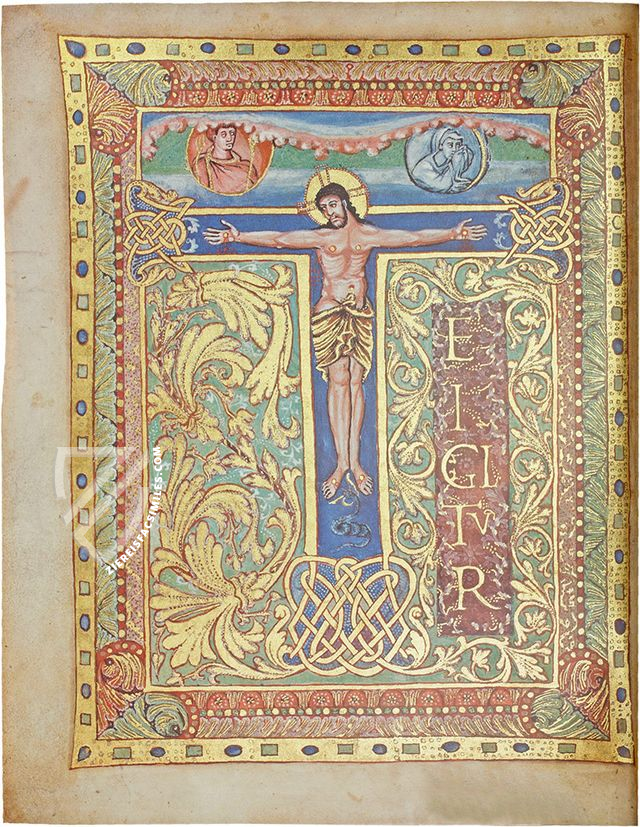
#1 Das Sakramentar von Metz
Language: German
The scholarly commentary which accompanies the manuscript was written by Florentine Mütherich and provides an introduction to the Sacramentary fragment. It places the manuscript in its historic context and particularly explains and acknowledges its place in the history of art.
(1,000€ - 3,000€)
#2 Sacramentario de Carlos el Calvo
Language: Spanish
- Treatises / Secular Books
- Apocalypses / Beatus
- Astronomy / Astrology
- Bestiaries
- Bibles / Gospels
- Chronicles / History / Law
- Geography / Maps
- Saints' Lives
- Islam / Oriental
- Judaism / Hebrew
- Single Leaf Collections
- Leonardo da Vinci
- Literature / Poetry
- Liturgical Manuscripts
- Medicine / Botany / Alchemy
- Music
- Mythology / Prophecies
- Psalters
- Other Religious Books
- Games / Hunting
- Private Devotion Books
- Other Genres
- Afghanistan
- Armenia
- Austria
- Belgium
- Belize
- Bosnia and Herzegovina
- China
- Colombia
- Costa Rica
- Croatia
- Cyprus
- Czech Republic
- Denmark
- Egypt
- El Salvador
- Ethiopia
- France
- Germany
- Greece
- Guatemala
- Honduras
- Hungary
- India
- Iran
- Iraq
- Israel
- Italy
- Japan
- Jordan
- Kazakhstan
- Kyrgyzstan
- Lebanon
- Liechtenstein
- Luxembourg
- Mexico
- Morocco
- Netherlands
- Palestine
- Panama
- Peru
- Poland
- Portugal
- Romania
- Russia
- Serbia
- Spain
- Sri Lanka
- Sweden
- Switzerland
- Syria
- Tajikistan
- Turkey
- Turkmenistan
- Ukraine
- United Kingdom
- United States
- Uzbekistan
- Vatican City
- A. Oosthoek, van Holkema & Warendorf
- Aboca Museum
- Ajuntament de Valencia
- Akademie Verlag
- Akademische Druck- u. Verlagsanstalt (ADEVA)
- Aldo Ausilio Editore - Bottega d’Erasmo
- Alecto Historical Editions
- Alkuin Verlag
- Almqvist & Wiksell
- Amilcare Pizzi
- Andreas & Andreas Verlagsbuchhandlung
- Archa 90
- Archiv Verlag
- Archivi Edizioni
- Arnold Verlag
- ARS
- Ars Magna
- ArtCodex
- AyN Ediciones
- Azimuth Editions
- Badenia Verlag
- Bärenreiter-Verlag
- Belser Verlag
- Belser Verlag / WK Wertkontor
- Benziger Verlag
- Bernardinum Wydawnictwo
- BiblioGemma
- Biblioteca Apostolica Vaticana (Vaticanstadt, Vaticanstadt)
- Bibliotheca Palatina Faksimile Verlag
- Bibliotheca Rara
- Boydell & Brewer
- Bramante Edizioni
- Bredius Genootschap
- Brepols Publishers
- British Library
- C. Weckesser
- Caixa Catalunya
- Canesi
- CAPSA, Ars Scriptoria
- Caratzas Brothers, Publishers
- Carus Verlag
- Casamassima Libri
- Centrum Cartographie Verlag GmbH
- Chavane Verlag
- Christian Brandstätter Verlag
- Circulo Cientifico
- Club Bibliófilo Versol
- Club du Livre
- CM Editores
- Collegium Graphicum
- Collezione Apocrifa Da Vinci
- Comissão Nacional para as Comemorações dos Descobrimentos Portugueses
- Coron Verlag
- Corvina
- CTHS
- D. S. Brewer
- Damon
- De Agostini/UTET
- De Nederlandsche Boekhandel
- De Schutter
- Deuschle & Stemmle
- Deutscher Verlag für Kunstwissenschaft
- DIAMM
- Droz
- E. Schreiber Graphische Kunstanstalten
- Ediciones Boreal
- Ediciones Grial
- Ediclube
- Edições Inapa
- Edilan
- Editalia
- Edition Deuschle
- Edition Georg Popp
- Edition Leipzig
- Edition Libri Illustri
- Editiones Reales Sitios S. L.
- Éditions de l'Oiseau Lyre
- Editions Medicina Rara
- Editorial Casariego
- Editorial Mintzoa
- Editrice Antenore
- Editrice Velar
- Edizioni Edison
- Egeria, S.L.
- Eikon Editores
- Electa
- Emery Walker Limited
- Enciclopèdia Catalana
- Eos-Verlag
- Ephesus Publishing
- Ernst Battenberg
- Eugrammia Press
- Extraordinary Editions
- Fackelverlag
- Facsimila Art & Edition
- Facsimile Editions Ltd.
- Facsimilia Art & Edition Ebert KG
- Faksimile Verlag
- Feuermann Verlag
- Folger Shakespeare Library
- Franco Cosimo Panini Editore
- Friedrich Wittig Verlag
- Fundación Hullera Vasco-Leonesa
- G. Braziller
- Gabriele Mazzotta Editore
- Gebr. Mann Verlag
- Gesellschaft für graphische Industrie
- Getty Research Institute
- Giovanni Domenico de Rossi
- Giunti Editore
- Graffiti
- Grafica European Center of Fine Arts
- Guido Pressler
- Guillermo Blazquez
- Gustav Kiepenheuer
- H. N. Abrams
- Harrassowitz
- Harvard University Press
- Helikon
- Hendrickson Publishers
- Henning Oppermann
- Herder Verlag
- Hes & De Graaf Publishers
- Hoepli
- Holbein-Verlag
- Houghton Library
- Hugo Schmidt Verlag
- Idion Verlag
- Il Bulino, edizioni d'arte
- ILte
- Imago
- Insel Verlag
- Insel-Verlag Anton Kippenberger
- Instituto de Estudios Altoaragoneses
- Instituto Nacional de Antropología e Historia
- Introligatornia Budnik Jerzy
- Istituto dell'Enciclopedia Italiana - Treccani
- Istituto Ellenico di Studi Bizantini e Postbizantini
- Istituto Geografico De Agostini
- Istituto Poligrafico e Zecca dello Stato
- Italarte Art Establishments
- Jan Thorbecke Verlag
- Johnson Reprint Corporation
- Josef Stocker
- Josef Stocker-Schmid
- Jugoslavija
- Karl W. Hiersemann
- Kasper Straube
- Kaydeda Ediciones
- Kindler Verlag / Coron Verlag
- Kodansha International Ltd.
- Konrad Kölbl Verlag
- Kurt Wolff Verlag
- La Liberia dello Stato
- La Linea Editrice
- La Meta Editore
- Lambert Schneider
- Landeskreditbank Baden-Württemberg
- Leo S. Olschki
- Les Incunables
- Liber Artis
- Library of Congress
- Libreria Musicale Italiana
- Lichtdruck
- Lito Immagine Editore
- Lumen Artis
- Lund Humphries
- M. Moleiro Editor
- Maison des Sciences de l'homme et de la société de Poitiers
- Manuscriptum
- Martinus Nijhoff
- Maruzen-Yushodo Co. Ltd.
- MASA
- Massada Publishers
- McGraw-Hill
- Metropolitan Museum of Art
- Militos
- Millennium Liber
- Müller & Schindler
- Nahar - Stavit
- Nahar and Steimatzky
- National Library of Wales
- Neri Pozza
- Nova Charta
- Oceanum Verlag
- Odeon
- Orbis Mediaevalis
- Orbis Pictus
- Österreichische Staatsdruckerei
- Oxford University Press
- Pageant Books
- Parzellers Buchverlag
- Patrimonio Ediciones
- Pattloch Verlag
- PIAF
- Pieper Verlag
- Plon-Nourrit et cie
- Poligrafiche Bolis
- Presses Universitaires de Strasbourg
- Prestel Verlag
- Princeton University Press
- Prisma Verlag
- Priuli & Verlucca, editori
- Pro Sport Verlag
- Propyläen Verlag
- Pytheas Books
- Quaternio Verlag Luzern
- Reales Sitios
- Recht-Verlag
- Reichert Verlag
- Reichsdruckerei
- Reprint Verlag
- Riehn & Reusch
- Roberto Vattori Editore
- Rosenkilde and Bagger
- Roxburghe Club
- Salerno Editrice
- Saltellus Press
- Sandoz
- Sarajevo Svjetlost
- Schöck ArtPrint Kft.
- Schulsinger Brothers
- Scolar Press
- Scrinium
- Scripta Maneant
- Scriptorium
- Shazar
- Siloé, arte y bibliofilia
- SISMEL - Edizioni del Galluzzo
- Sociedad Mexicana de Antropología
- Société des Bibliophiles & Iconophiles de Belgique
- Soncin Publishing
- Sorli Ediciones
- Stainer and Bell
- Studer
- Styria Verlag
- Sumptibus Pragopress
- Szegedi Tudomànyegyetem
- Taberna Libraria
- Tarshish Books
- Taschen
- Tempus Libri
- Testimonio Compañía Editorial
- Thames and Hudson
- The Clear Vue Publishing Partnership Limited
- The Facsimile Codex
- The Folio Society
- The Marquess of Normanby
- The Richard III and Yorkist History Trust
- Tip.Le.Co
- TouchArt
- TREC Publishing House
- TRI Publishing Co.
- Trident Editore
- Tuliba Collection
- Typis Regiae Officinae Polygraphicae
- Union Verlag Berlin
- Universidad de Granada
- University of California Press
- University of Chicago Press
- Urs Graf
- Vallecchi
- Van Wijnen
- VCH, Acta Humaniora
- VDI Verlag
- VEB Deutscher Verlag für Musik
- Verlag Anton Pustet / Andreas Verlag
- Verlag Bibliophile Drucke Josef Stocker
- Verlag der Münchner Drucke
- Verlag für Regionalgeschichte
- Verlag Styria
- Vicent Garcia Editores
- W. Turnowski Ltd.
- W. Turnowsky
- Waanders Printers
- Wiener Mechitharisten-Congregation (Wien, Österreich)
- Wissenschaftliche Buchgesellschaft
- Wissenschaftliche Verlagsgesellschaft
- Wydawnictwo Dolnoslaskie
- Xuntanza Editorial
- Zakład Narodowy
- Zollikofer AG

